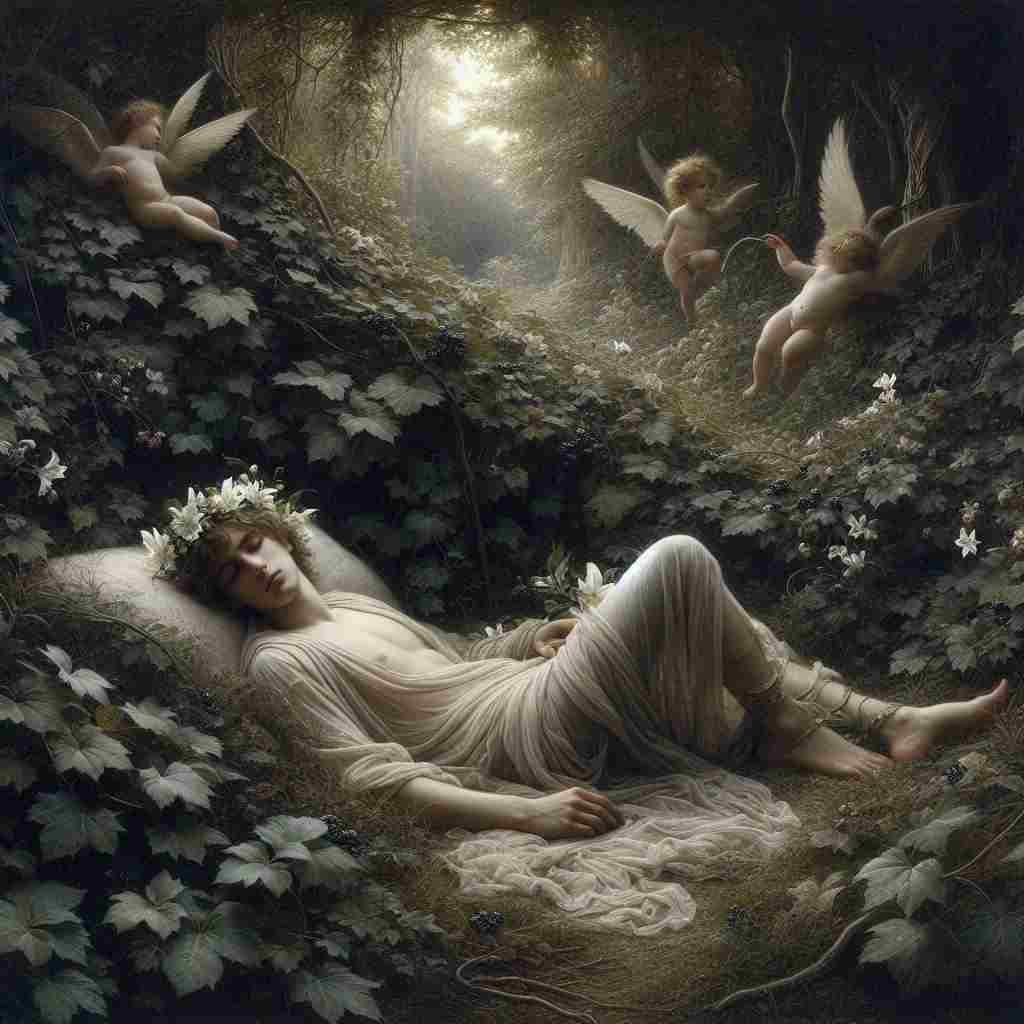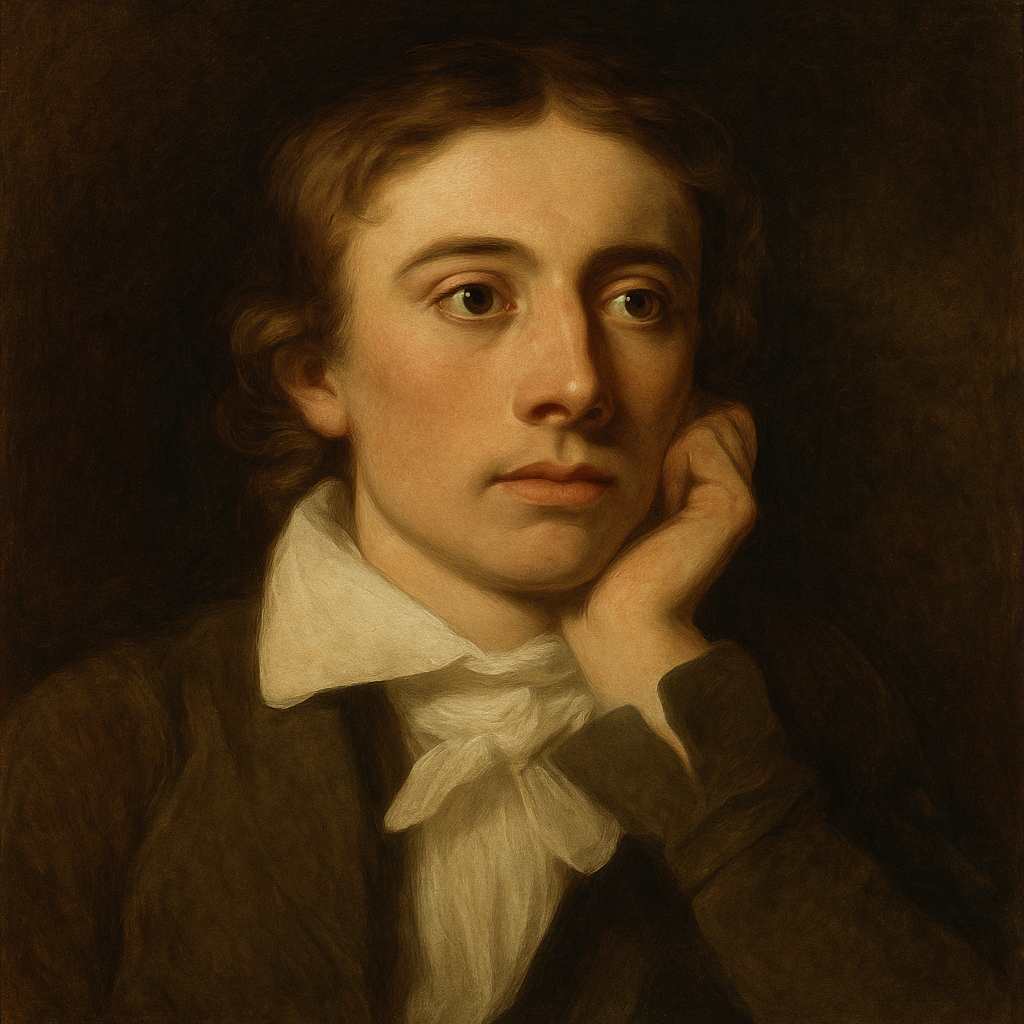Adonis Sleeping
John Keats
1795 to 1821

In midst of all, there lay a sleeping youth
Of fondest beauty. Sideway his face reposed
On one white arm, and tenderly unclosed,
By tenderest pressure, a faint damask mouth
To slumbery pout; just as the morning south
Disparts a dew-lipp'd rose. Above his head,
Four lily stalks did their white honours wed
To make a coronal; and round him grew
All tendrils green, of every bloom and hue,
Together intertwined and trammel'd fresh:
The vine of glossy sprout; the ivy mesh,
Shading its Ethiop berries; and woodbine,
Of velvet leaves, and bugle blooms divine.
Hard by,
Stood serene Cupids watching silently.
One, kneeling to a lyre, touch'd the strings,
Muffling to death the pathos with his wings;
And, ever and anon, uprose to look
At the youth's slumber; while another took
A willow bough, distilling odorous dew,
And shook it on his hair; another flew
In through the woven roof, and fluttering-wise,
Rain'd violets upon his sleeping eyes.
John Keats's Adonis Sleeping
The poem "Adonis Sleeping" by John Keats is an excerpt from his larger work "Endymion: A Poetic Romance" (1818), which is a complex, richly descriptive narrative poem. It draws on Greek mythology, romantic ideals, and Keats's exploration of beauty and transcendence. The lines here vividly describe the sleeping figure of Adonis, an archetypal figure of male beauty in classical mythology.
Introduction
In this excerpt, Keats uses his characteristic lush imagery and classical allusions to depict the repose of Adonis, a figure of divine beauty and vulnerability. The scene is both pastoral and celestial, imbued with the opulence of natural imagery and a heightened sense of stillness. This portrayal of Adonis aligns with Keats's broader poetic preoccupation with beauty, both mortal and immortal, and with the power of nature to evoke transcendence. Through the interplay of mythological figures, symbolic natural imagery, and the subtle infusion of musicality, Keats conveys a moment of divine stillness, reminiscent of the Keatsian concept of "negative capability."
Imagery of Beauty and Nature
Keats's poetic lens magnifies the sleeping Adonis into an icon of ethereal beauty. The youth's face is described as "reposed / On one white arm," a tender image that evokes fragility and perfection. His "faint damask mouth," likened to a "dew-lipp’d rose," captures both sensuality and delicacy. This metaphor not only emphasizes the softness and purity of Adonis's beauty but also situates him within a natural framework, where his physicality merges with the organic world.
The surrounding natural imagery—"tendrils green, of every bloom and hue"—creates a setting of paradisiacal abundance. Keats meticulously names each plant:
- The vine with "glossy sprout," symbolic of vitality and renewal,
- Ivy mesh, evocative of permanence and attachment,
- Woodbine with "velvet leaves" and "bugle blooms divine," suggestive of harmony and fragility.
This interweaving of plants mirrors the theme of interconnectedness between human beauty and the natural world.
Mythological Allusions
Adonis is a central figure in Greek mythology, often associated with beauty, love, and tragic mortality. In classical tradition, Adonis is loved by Aphrodite and dies tragically, emphasizing the fleeting nature of perfection. Keats imbues this mythological reference with an almost sculptural stillness, freezing Adonis in a state of eternal repose.
The serene Cupids, traditionally associated with love and desire, perform acts of quiet devotion:
- One "kneeling to a lyre, touch'd the strings," muffling its music "with his wings." This detail juxtaposes the potential pathos of the music with the imposed silence of reverence, enhancing the atmosphere of suspended time.
- Another Cupid uses a "willow bough, distilling odorous dew" to bless the sleeping youth, a ritualistic act suggestive of sanctification.
- A third rains "violets upon his sleeping eyes," linking Adonis to a dreamlike, otherworldly state.
These actions elevate Adonis's rest into a scene of divine adoration, underscoring his symbolic role as an embodiment of ideal beauty.
Themes of Sleep and Stillness
Keats frequently explores the motif of sleep as a liminal state between life and death, or between the mortal and immortal realms. Adonis's "slumbery pout" and the Cupids' quiet ministrations create a tableau of profound calm. The setting seems to exist outside of time, a hallmark of Keats's fascination with moments of eternal beauty.
The use of aural imagery—the lyre "muffling to death the pathos"—further contributes to the somnolent atmosphere, where even music, an emblem of vitality and passion, is subdued to respect the sanctity of Adonis's sleep.
Symbolism and Form
The excerpt reflects the Romantic idealization of nature and myth, as well as Keats's belief in art's power to immortalize fleeting moments of beauty. The intertwined tendrils and woven roof suggest a unity between the mortal and the divine, reinforcing the Romantic principle of interconnectedness.
Keats's use of enjambment propels the poem's lush descriptions forward, mimicking the organic flow of vines and flowers. The poem's structure, though fluid, subtly mirrors the stillness of the scene, with frequent pauses (caesuras) that slow the rhythm, compelling readers to linger on each image.
Conclusion
In "Adonis Sleeping," John Keats crafts an evocative tableau that blends classical mythology with Romantic ideals. The sleeping Adonis becomes a symbol of transcendent beauty, while the surrounding nature and ministrations of the Cupids reflect humanity's reverence for fleeting perfection. This passage exemplifies Keats's mastery of sensory detail and mythological resonance, aligning with the themes of Endymion as a whole: the pursuit of beauty and its elusive, almost sacred nature. Through this poetic fragment, Keats invites readers to contemplate the transient yet eternal qualities of idealized beauty.
This text was generated by AI and is for reference only. Learn more
Want to join the discussion? Reopen or create a unique username to comment. No personal details required!



Comments
No comments yet. Be the first to comment!